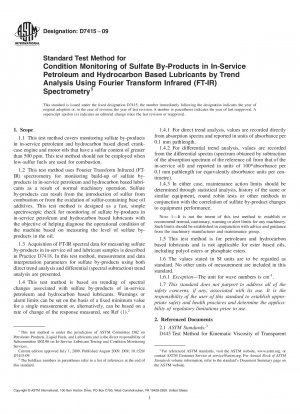ASTM D7415-09
Standard Test Method for Condition Monitoring of Sulfate By-Products in In-Service Petroleum and Hydrocarbon Based Lubricants by Trend Analysis Using Fourier Transform Infrared (FT-IR) Spectrometry
- Standard No.
- ASTM D7415-09
- Release Date
- 2009
- Published By
- American Society for Testing and Materials (ASTM)
- Status
- Replace By
- ASTM D7415-18
- Latest
- ASTM D7415-22
- Scope
An increase in sulfate material can be an indicator of oil degradation caused by oxidation of sulfur in the oil and sulfur in fuel. It can also indicate the breakdown or oxidation of some key additives in the oil such as antiwear and extreme pressure additives as well as blow-by concerns. As oxidized sulfur from blow-by enters the lubricant, it will consume the overbase additive to generate sulfate by-products. Monitoring of sulfate by-products is therefore an important parameter in determining overall machinery health and in determining additive depletion and should be considered in conjunction with data from other tests such as atomic emission (AE) and atomic absorption (AA) spectroscopy for wear metal analysis (Test Method D 5185
), physical property tests (Test Methods D 445 , D 2896 , and D 6304 ), base number tests (Test Methods D 974 and D 4739 ) and other FT-IR oil analysis methods for nitration (Practice E 2412 ), oxidation (Test Method D 7414 ), additive depletion (Test Method D 7412 ), breakdown products and external contaminants (Practice E 2412 ), which also assess elements of the oil’s condition, see Refs (1-6) 1.1 This test method covers monitoring sulfate by-products in in-service petroleum and hydrocarbon based diesel crankcase engine and motor oils that have a sulfur content of greater than 500 ppm. This test method should not be employed when low-sulfur fuels are used for combustion.
1.2 This test method uses Fourier Transform Infrared (FT-IR) spectrometry for monitoring build-up of sulfate by-products in in-service petroleum and hydrocarbon based lubricants as a result of normal machinery operation. Sulfate by-products can result from the introduction of sulfur from combustion or from the oxidation of sulfur-containing base oil additives. This test method is designed as a fast, simple spectroscopic check for monitoring of sulfate by-products in in-service petroleum and hydrocarbon based lubricants with the objective of helping diagnose the operational condition of the machine based on measuring the level of sulfate by-products in the oil.
1.3 Acquisition of FT-IR spectral data for measuring sulfate by-products in in-service oil and lubricant samples is described in Practice D 7418
. In this test method, measurement and data interpretation parameters for sulfate by-products using both direct trend analysis and differential (spectral subtraction) trend analysis are presented. 1.4 This test method is based on trending of spectral changes associated with sulfate by-products of in-service petroleum and hydrocarbon based lubricants. Warnings or alarm limits can be set on the basis of a fixed minimum value for a single measurement or, alternatively, can be based on a rate of change of the response measured, see Ref (1).
1.4.1 For direct trend analysis, values are recorded directly from absorption spectra and reported in units of absorbance per 0.1 mm pathlength.
1.4.2 For differential trend analysis, values are recorded from the differential spectra (spectrum obtained by subtraction of the absorption spectrum of the reference oil from that of the in-service oil) and reported in units of 100*absorbance per 0.1 mm pathlength (or equivalently absorbance units per centimetre).
1.4.3 In either case, maintenance action limits should be determined through statistical analysis, history of the same or similar equipment, round robin tests or other methods in conjunction with the correlation of sulfate by-product changes to equipment performance.
Note 18212;It is not the intent of this test method to establish or recommend ......
ASTM D7415-09 Referenced Document
- ASTM D2896 Standard Test Method for Base Number of Petroleum Products by Potentiometric Perchloric Acid Titration
- ASTM D445 Standard Test Method for Kinematic Viscosity of Transparent and Opaque Liquids (the Calculation of Dynamic Viscosity)
- ASTM D4739 Standard Test Method for Base Number Determination by Potentiometric Titration
- ASTM D5185 Standard Test Method for Determination of Additive Elements, Wear Metals, and Contaminants in Used Lubricating Oils and Determination of Selected Elements in Base Oils by Inductively Coupled Plasma Atomic Emission Spectrometry (ICP-AES)
- ASTM D6304 Standard Test Method for Determination of Water in Petroleum Products, Lubricating Oils, and Additives by Coulometric Karl Fischer Titration
- ASTM D7412 Standard Test Method for Condition Monitoring of Phosphate Antiwear Additives in In-Service Petroleum and Hydrocarbon Based Lubricants by Trend Analysis Using Fourier Transform Infrared (FT-IR) Spectr
- ASTM D7414 Standard Test Method for Condition Monitoring of Oxidation in In-Service Petroleum and Hydrocarbon Based Lubricants by Trend Analysis Using Fourier Transform Infrared (FT-IR) Spectrometry
- ASTM D7418 Standard Practice for Set-Up and Operation of Fourier Transform Infrared (FT-IR) Spectrometers for In-Service Oil Condition Monitoring
- ASTM D974 Standard Test Method for Acid and Base Number by Color-Indicator Titration
- ASTM E131 Standard Definitions of Terms and Symbols Relating to Molecular Spectroscopy
- ASTM E2412 Standard Practice for Condition Monitoring of In-Service Lubricants by Trend Analysis Using Fourier Transform Infrared (FT-IR) Spectrometry
ASTM D7415-09 history
- 2022 ASTM D7415-22 Standard Test Method for Condition Monitoring of Sulfate By-Products in In-Service Petroleum and Hydrocarbon Based Lubricants by Trend Analysis Using Fourier Transform Infrared (FT-IR) Spectrometry
- 2021 ASTM D7415-21 Standard Test Method for Condition Monitoring of Sulfate By-Products in In-Service Petroleum and Hydrocarbon Based Lubricants by Trend Analysis Using Fourier Transform Infrared (FT-IR) Spectrometry
- 2018 ASTM D7415-18 Standard Test Method for Condition Monitoring of Sulfate By-Products in In-Service Petroleum and Hydrocarbon Based Lubricants by Trend Analysis Using Fourier Transform Infrared (FT-IR) Spectrometry
- 2009 ASTM D7415-09 Standard Test Method for Condition Monitoring of Sulfate By-Products in In-Service Petroleum and Hydrocarbon Based Lubricants by Trend Analysis Using Fourier Transform Infrared (FT-IR) Spectrometry
